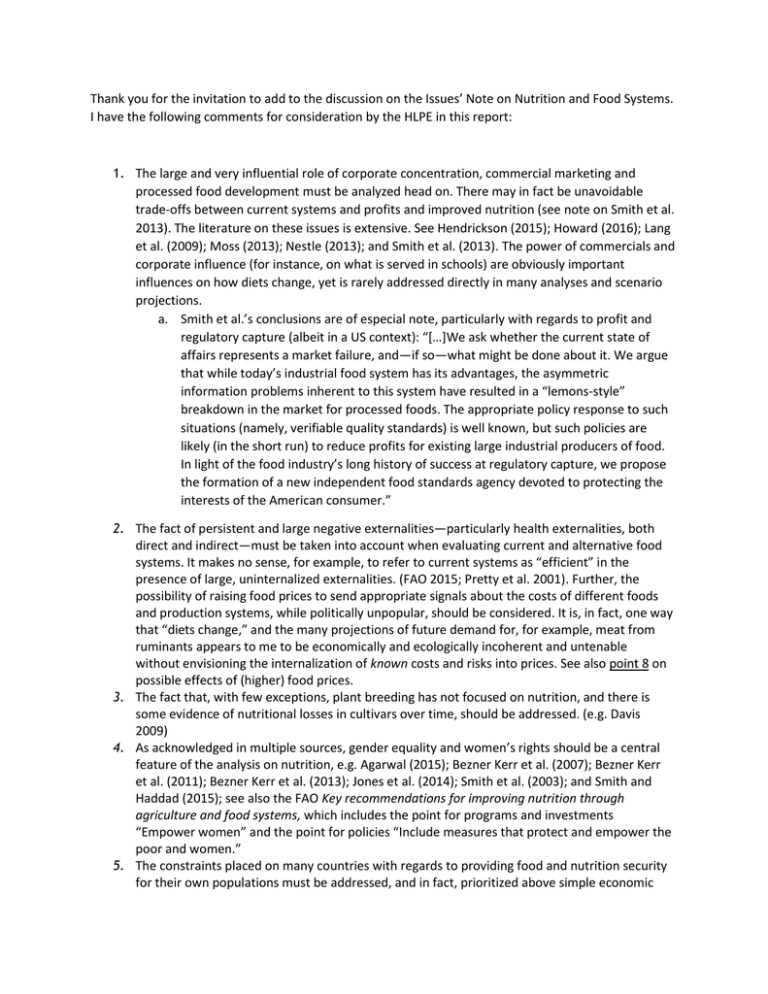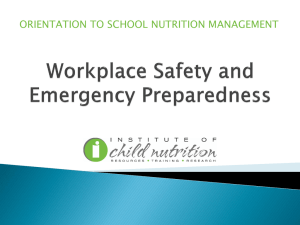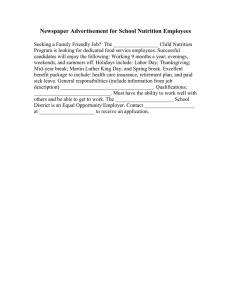Document 15755783
advertisement

Thank you for the invitation to add to the discussion on the Issues’ Note on Nutrition and Food Systems. I have the following comments for consideration by the HLPE in this report: 1. The large and very influential role of corporate concentration, commercial marketing and processed food development must be analyzed head on. There may in fact be unavoidable trade-offs between current systems and profits and improved nutrition (see note on Smith et al. 2013). The literature on these issues is extensive. See Hendrickson (2015); Howard (2016); Lang et al. (2009); Moss (2013); Nestle (2013); and Smith et al. (2013). The power of commercials and corporate influence (for instance, on what is served in schools) are obviously important influences on how diets change, yet is rarely addressed directly in many analyses and scenario projections. a. Smith et al.’s conclusions are of especial note, particularly with regards to profit and regulatory capture (albeit in a US context): “[…]We ask whether the current state of affairs represents a market failure, and—if so—what might be done about it. We argue that while today’s industrial food system has its advantages, the asymmetric information problems inherent to this system have resulted in a “lemons-style” breakdown in the market for processed foods. The appropriate policy response to such situations (namely, verifiable quality standards) is well known, but such policies are likely (in the short run) to reduce profits for existing large industrial producers of food. In light of the food industry’s long history of success at regulatory capture, we propose the formation of a new independent food standards agency devoted to protecting the interests of the American consumer.” 2. The fact of persistent and large negative externalities—particularly health externalities, both direct and indirect—must be taken into account when evaluating current and alternative food systems. It makes no sense, for example, to refer to current systems as “efficient” in the presence of large, uninternalized externalities. (FAO 2015; Pretty et al. 2001). Further, the possibility of raising food prices to send appropriate signals about the costs of different foods and production systems, while politically unpopular, should be considered. It is, in fact, one way that “diets change,” and the many projections of future demand for, for example, meat from ruminants appears to me to be economically and ecologically incoherent and untenable without envisioning the internalization of known costs and risks into prices. See also point 8 on possible effects of (higher) food prices. 3. The fact that, with few exceptions, plant breeding has not focused on nutrition, and there is some evidence of nutritional losses in cultivars over time, should be addressed. (e.g. Davis 2009) 4. As acknowledged in multiple sources, gender equality and women’s rights should be a central feature of the analysis on nutrition, e.g. Agarwal (2015); Bezner Kerr et al. (2007); Bezner Kerr et al. (2011); Bezner Kerr et al. (2013); Jones et al. (2014); Smith et al. (2003); and Smith and Haddad (2015); see also the FAO Key recommendations for improving nutrition through agriculture and food systems, which includes the point for programs and investments “Empower women” and the point for policies “Include measures that protect and empower the poor and women.” 5. The constraints placed on many countries with regards to providing food and nutrition security for their own populations must be addressed, and in fact, prioritized above simple economic returns and trade considerations for corporations—which was not done during the formation of the FAO, as McKeon (2014) elaborates. See also Weis (2007) for a discussion of the impacts of the Agreement on Agriculture. 6. The growing literature on connections between crop diversity and dietary diversity should be amply explored; e.g. Burlingame and Dernini (2012); with the contexts of food sovereignty and autonomy considered alongside. 7. The growing realization of the importance of dietary diversity per se should be addressed, e.g. Smith and Haddad 2015; Heady and Ecker (2013). 8. A sophisticated analysis of nutrition, production, productivity, and prices must be undertaken. While there has long been an assumption that increasing productivity for farmers will increase their well-being, nutrition, and income, the possibility that higher prices is equally or more important or effective is seldom seriously addressed. But contemporary analyses and reanalyses of earlier data have solidly (though arguably not yet conclusivelyl) shown that higher food prices may in fact be better for farmers, and indeed, may drive up urban and rural wages (and therefore improve the possibilities for food and nutrition security); Headey (2014); Ivanic and Will (2014). Therefore, the typical assumption of productivity increased farmer income lower food prices improved nutrition outcomes should be interrogated, questioned, and likely revised in the face of current evidence. 9. The significant contribution to dietary diversity and food security from urban agriculture should be acknowledged and carefully examined; Thebo et al. 2014; Zezza and Tasciotti 2014. 10. Cultural and ethical values, and their interaction with nutrition, food sovereignty, and autonomy (not autarky) should also be explicitly considered and their significance allowed due weight. This includes, but is not limited to, the importance of participation and empowerment, as recognized in the Key recommendations for improving nutrition through agriculture and food systems, which is based on a consensus process among nutritionists and related experts. Thank you again for the opportunity to submit comments towards this important work. M. Jahi Chappell, Ph.D. Senior Staff Scientist Institute for Agriculture and Trade Policy Minneapolis, MN, USA References Cited Agarwal, B. (2015). Food Security, Productivity, and Gender Inequality. In R. J. Herring (Ed.),The Oxford Handbook of Food, Politics, and Society. Oxford: Oxford University Press. Bezner Kerr, R., Berti, P. R., & Shumba, L. (2011). Effects of a participatory agriculture and nutrition education project on child growth in northern Malawi. Public Health Nutrition, 14(08), 14661472. Bezner Kerr, R., Snapp, S., Chirwa, M., Shumba, L., & Msachi, R. (2007). Participatory research on legume diversification with Malawian smallholder farmers for improved human nutrition and soil fertility. Experimental Agriculture, 43(04), 437-453. Bezner-Kerr, R., Lupafya, E., & Shumba, L. (2013). Food Sovereignty, Gender and Nutrition: Perspectives from Malawi: Conference Paper #68. Paper presented at the Food Sovereignty: A Critical Dialogue, Yale University, New Haven, CT. http://www.iss.nl/fileadmin/ASSETS/iss/Research_and_projects/Research_networks/ICAS/68_ BeznerKerr_2013.pdf Burlingame, B., & Dernini, S. (Eds.). (2012). Sustainable Diets and Biodiversity: Directions and solutions for policy, research and action. Rome: Food and Agriculture Organization of the United Nations. Davis, D. R. (2009). Declining Fruit and Vegetable Nutrient Composition: What Is the Evidence? HortScience, 44(1), 15-19. Food and Agriculture Organization of the United Nations (FAO). (2013). Key recommendations for improving nutrition through agriculture and food systems. Retrieved from Rome: http://unscn.org/files/Agriculture-Nutrition-CoP/AgricultureNutrition_Key_recommendations.pdf Food and Agriculture Organization of the United Nations (FAO). (2015). Natural Capital Impacts in Agriculture: Supporting Better Business Decision-Making. Retrieved from Rome: http://www.fao.org/fileadmin/templates/nr/sustainability_pathways/docs/Final_Natural_Capit al_Impacts_in_Agriculture_-_Supporting_Better_Business_Descision-Making_v5.0.pdf Headey, D. (2014). Food prices and poverty reduction in the long run (1331). Retrieved from Washington, D.C.: http://ebrary.ifpri.org/cdm/ref/collection/p15738coll2/id/128056 Headey, D., & Ecker, O. (2013). Rethinking the measurement of food security: from first principles to best practice. Food Security, 5(3), 327-343. doi:10.1007/s12571-013-0253-0 Hendrickson, M. K. (2015). Resilience in a concentrated and consolidated food system. Journal of Environmental Studies and Sciences, 5(3), 418-431. doi:10.1007/s13412-015-0292-2 Howard, P. H. (2016). Concentration and Power in the Food System: Who Controls What We Eat? London: Bloomsbury Academic Publishing. Ivanic, M., & Martin, W. (2014). Short-and long-run impacts of food price changes on poverty.World Bank Policy Research Working Paper(7011). Jones, A. D., Shrinivas, A., & Bezner-Kerr, R. (2014). Farm production diversity is associated with greater household dietary diversity in Malawi: Findings from nationally representative data. Food Policy, 46(0), 1-12. doi:http://dx.doi.org/10.1016/j.foodpol.2014.02.001 Lang, T., Barling, D., & Caraher, M. (2009). Food policy: Integrating health, environment & society. Oxford, UK; New York, USA: Oxford University Press. McKeon, N. (2014). Food Security Governance: Empowering Communities, Regulating Corporations: Routledge. Moss, M. (2013). Salt, sugar, fat: how the food giants hooked us: Random House. Nestle, M. (2013). Food politics: How the food industry influences nutrition and health: University of California Press. Pretty, J., Brett, C., Gee, D., Hine, R., Mason, C., Morison, J., . . . Dobbs, T. (2001). Policy Challenges and Priorities for Internalizing the Externalities of Modern Agriculture. Journal of Environmental Planning and Management, 44(2), 263-283. doi:10.1080/09640560123782 Smith, L. C., & Haddad, L. (2015). Reducing Child Undernutrition: Past Drivers and Priorities for the PostMDG Era. World Development, 68(0), 180-204. doi:http://dx.doi.org/10.1016/j.worlddev.2014.11.014 Smith, L. C., Ramakrishnan, U., Ndiaye, A., Haddad, L., & Martorell, R. (2003). The importance of women's status for child nutrition in developing countries (131). Retrieved from Washington, D.C.: http://www.ifpri.org/publication/importance-womens-status-child-nutrition-developingcountries Smith, T. G., Chouinard, H. H., & Wandschneider, P. R. (2011). Waiting for the invisible hand: Novel products and the role of information in the modern market for food. Food Policy, 36(2), 239249. Thebo, A. L., Drechsel, P., & Lambin, E. F. (2014). Global assessment of urban and peri-urban agriculture: irrigated and rainfed croplands. Environmental Research Letters, 9(11), 114002. Weis, T. (2007). The Global Food Economy: The Battle for the Future of Farming. Blackpoint, NS. Canada: Fernwood Publishing. Zezza, A., & Tasciotti, L. (2010). Urban agriculture, poverty, and food security: Empirical evidence from a sample of developing countries. Food Policy, 35(4), 265-273.



